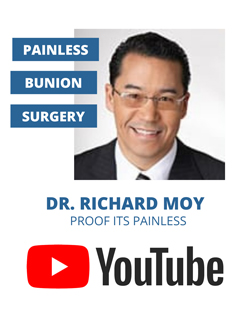No matter what you may have been told, every surgeon has complications. The questions one needs to ask are: “What is the severity of those complications?” and “What is the frequency of them occurring for that given procedure, by that given surgeon?”
Dr.Moy’s complication rate is extremely small and the severity of those conditions is rather minor.
Foot Irritation From Retained Hardware
Our number one complication is irritation from the retained hardware or screw. Certain styles of shoes may press down on the top of the foot. The screw head is approx 2-3mm above the bone, so that small area can create swelling and discomfort to the top of the foot.
Furthermore, extremely active patients can force that screw to work its way up out of the bone. The screw does not have to be removed, unless it causes discomfort. Approximately 15% of patients request to have the screw removed.
Excessive Joint Stiffness
Our next complication is excessive joint stiffness, which occurs in about 2-3% of patients. Patients who have a combination of hallux limitus and bunions may be more susceptible to this due to the nature of the condition.
Furthermore, we have realized that certain ethnicities have poor tissue elasticity and consequently end up with more stiffness than the average patient. If the toe does not bend up high enough, patients may have discomfort on the top of the joint. If the toe does not move down adequately, they may have soreness on the bottom of the joint where the sesmoid bones become more prominent. Consequently, in loosening up the joint surgically, patients do extremely well and gain a tremendous increase in the range of motion. Subsequently the pain usually subsides.
Joint stiffness can also be contributed to poor efforts on the patient’s behalf to follow post-operative exercises. The patient must be on top of those exercises to prevent this as well.
In about 2% of patients, contact dermatitis occurs, which is an allergic reaction to the topical adhesive applied to the skin prior to application of the steri strips. If blistering occurs, the patient is treated with a topical steroid and the skin heals nicely after a period of 2-3 weeks.
Sub-second metatarsalgia is when patients notice discomfort under the second metatarsal head as a result of changing the way they walk.
Other reasons can be because the first metatarsal shaft needs to be shortened or invariably the second metatarsal shaft is inherently too long or plantar flexed. Hammertoes of the second toe can also contribute to this complication. If the condition is mild, a simple orthotic in the shoe padding will suffice for this condition. If the condition is more severe, a simple MPJ release to reduce the hammertoe contracture or possibly a shortening procedure of the second metatarsal would alleviate this condition.
Sesmoiditis occurs in less than 1% of our patients. The repositioning of the two small bones underneath the first metatarsal causes this. In many cases, an orthotic with a cut out in the first metatarsal joint would alleviate the discomfort. If the discomfort is severe, the patient would need to have one of the sesmoids removed.
Infection Occurring in Less Than 1% of Patients
Another complication is infection and it occurs in less than 1% of our patients. Oral antibiotics can treat this and in 2-4 days should clear up, although we prescribe a 10-day dosage to make sure the infection is 100% cleared
